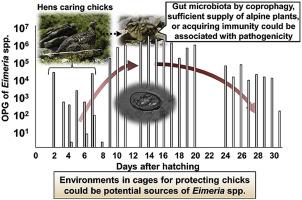当前位置:
X-MOL 学术
›
Int. J. Parasitol. Parasites Wildl.
›
论文详情
Our official English website, www.x-mol.net, welcomes your feedback! (Note: you will need to create a separate account there.)
Parasitic development in intestines and oocyst shedding patterns for infection by Eimeria uekii and Eimeria raichoi in Japanese rock ptarmigans, Lagopus muta japonica, protected by cages in the Southern Japanese Alps.
International Journal for Parasitology: Parasites and Wildlife ( IF 1.8 ) Pub Date : 2020-04-09 , DOI: 10.1016/j.ijppaw.2020.04.002 Makoto Matsubayashi 1, 2, 3, 4 , Moemi Kinoshita 1 , Atsushi Kobayashi 5 , Sayaka Tsuchida 6 , Tomoyuki Shibahara 1, 7 , Masami Hasegawa 5 , Hiroshi Nakamura 8 , Kazumi Sasai 1, 2 , Kazunari Ushida 6
International Journal for Parasitology: Parasites and Wildlife ( IF 1.8 ) Pub Date : 2020-04-09 , DOI: 10.1016/j.ijppaw.2020.04.002 Makoto Matsubayashi 1, 2, 3, 4 , Moemi Kinoshita 1 , Atsushi Kobayashi 5 , Sayaka Tsuchida 6 , Tomoyuki Shibahara 1, 7 , Masami Hasegawa 5 , Hiroshi Nakamura 8 , Kazumi Sasai 1, 2 , Kazunari Ushida 6
Affiliation

|
The population of Japanese rock ptarmigan (Lagopus muta japonica), an endangered species with a habitat above the timberline of the southern Japanese Alps, has declined. As one of the recent conservation strategies for this species, cage protection for broods (hens and chicks) has been introduced in their habitats. Two species of Eimeria have frequently been detected in these birds, but little is known about the parasitic circulation in the region, including among birds and in the environment. Here, we conducted histopathology examinations of dead chicks collected under cage protection in 2018, and examined the feces of the hens and chicks of three broods and environmental soils for parasites in 2019 in order to assess the potential sources of infection and pathogenicity. Developmental zoites were found in the epithelial mucosa and/or the submucosa from the duodenum to the colon of all dead chicks. Fecal examination revealed oocysts of E. uekii and/or E. raichoi in all hens and chicks. Oocysts of Eimeria spp. per gram of feces in chicks increased within 2 weeks after hatching and then gradually deceased. Following infection of the chicks, oocysts could accumulate within the cage areas, and oocyst density exceeded more than 1000 oocysts per gram of cage soils. Based on having sporulated morphologies, oocysts could be infective and therefore, be direct or indirect potential sources of infection. However, based on our findings that not all chicks were clinically affected by the infections, other factors such as microbial flora in the chicks established by coprophagy or from the habitat environment, including climate, might be associated with the pathogenicity of Eimeria spp., although further studies are needed to assess these correlations.
中文翻译:

在日本南部阿尔卑斯山的笼子中,日本岩雷鸟(Lagopus muta japonica)的肠道寄生虫和卵囊脱落模式会被艾美球虫经皮和艾美球虫感染所感染。
日本岩雷鸟(Lagopus muta japonica)是一种濒临灭绝的物种,其栖息地高于日本阿尔卑斯山南部的林线,其种群数量有所减少。作为该物种的近期保护策略之一,已在其栖息地中引入了对雏鸡(母鸡和小鸡)的笼子保护。在这些鸟类中经常发现两种艾美球虫属,但对该地区(包括鸟类之间和环境中)的寄生虫传播知之甚少。在这里,我们对2018年在笼子保护下收集的死亡小鸡进行了组织病理学检查,并在2019年检查了三种育雏和环境土壤中母鸡和小鸡的粪便中是否有寄生虫,以评估潜在的感染和致病性来源。在所有死亡小鸡的十二指肠到结肠的上皮粘膜和/或粘膜下层中发现了发育的动物。粪便检查发现所有母鸡和小鸡均存在上皮大肠杆菌和/或莱希大肠杆菌的卵囊。艾美球虫的卵囊。孵化后2周内,小鸡每克粪便中的每克粪便增加,然后逐渐死亡。感染小鸡后,卵囊可能会在笼区内积聚,卵囊密度超过每克笼土1000多个卵囊。基于孢子形的形态,卵囊可能具有感染性,因此是直接或间接的潜在感染源。但是,根据我们的发现,并不是所有的雏鸡在临床上都受到感染的影响,其他因素(例如,通过共同传播或从栖息地环境中建立的雏鸡中的微生物菌群,包括气候,
更新日期:2020-04-09
中文翻译:

在日本南部阿尔卑斯山的笼子中,日本岩雷鸟(Lagopus muta japonica)的肠道寄生虫和卵囊脱落模式会被艾美球虫经皮和艾美球虫感染所感染。
日本岩雷鸟(Lagopus muta japonica)是一种濒临灭绝的物种,其栖息地高于日本阿尔卑斯山南部的林线,其种群数量有所减少。作为该物种的近期保护策略之一,已在其栖息地中引入了对雏鸡(母鸡和小鸡)的笼子保护。在这些鸟类中经常发现两种艾美球虫属,但对该地区(包括鸟类之间和环境中)的寄生虫传播知之甚少。在这里,我们对2018年在笼子保护下收集的死亡小鸡进行了组织病理学检查,并在2019年检查了三种育雏和环境土壤中母鸡和小鸡的粪便中是否有寄生虫,以评估潜在的感染和致病性来源。在所有死亡小鸡的十二指肠到结肠的上皮粘膜和/或粘膜下层中发现了发育的动物。粪便检查发现所有母鸡和小鸡均存在上皮大肠杆菌和/或莱希大肠杆菌的卵囊。艾美球虫的卵囊。孵化后2周内,小鸡每克粪便中的每克粪便增加,然后逐渐死亡。感染小鸡后,卵囊可能会在笼区内积聚,卵囊密度超过每克笼土1000多个卵囊。基于孢子形的形态,卵囊可能具有感染性,因此是直接或间接的潜在感染源。但是,根据我们的发现,并不是所有的雏鸡在临床上都受到感染的影响,其他因素(例如,通过共同传播或从栖息地环境中建立的雏鸡中的微生物菌群,包括气候,



























 京公网安备 11010802027423号
京公网安备 11010802027423号